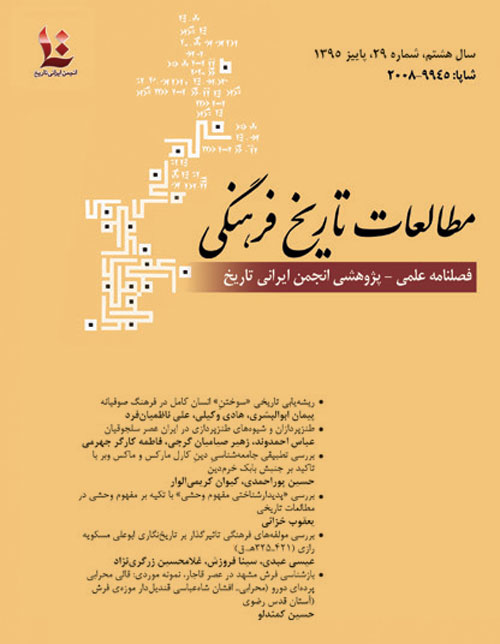فهرست مطالب

فصلنامه مطالعات تاریخ فرهنگی
پیاپی 29 (پاییز 1395)
- تاریخ انتشار: 1395/09/25
- تعداد عناوین: 5
-
-
Pages 1-22Mystical and Sufism texts had witnessed the creation of famous motif named candle and butterfly with content of burning and sacrifice which gradually used in poetical works of Sufi poets and rarely developed in the Iranian culture and literature until contemporary era as a stereotype. Theories have been offered about the source of the content of burning. But it seems that due to the fact that burning of complete humankind neither had place in Muslim beliefs and traditions nor in religion of ancient Iran, it has to be related to the common geography of the great Khorasan with eastern lands, the role of silk road and semantic companionship of the tradition of the burning of complete humankind in Indo-Buddhism religions and sources of candle and butterfly in mystical poems of poets to other discourse. The aim of this article is to determine the possibility of the effectiveness amount of Indo-Buddhism tradition and transmission and transformation of the content of burning in Muslim mystical discourse in the symbolic motif of candle and butterfly.Keywords: Complete Humankind, Sufism, Indo-Buddhism Religions, Burning, Candle, Butterfly
-
Pages 23-48In Islamic Iranian society of Seljuq era, satire was used for laughable and sarcasm expression of various issues of society. There is a definition in modern historiography of Islamic Iranian literature that the meaning of satirist has the same modern meaning of aiming for socio-political criticism. It was a literary activity that mostly done and promoted by poets. Due to this rather literary attitude towards satire, if we consider the concept of satire beyond its current meaning as paradox, what had been the position of satire meaning and subject in various stratums in this period? The issue of this article is to study of the position of satire in Islamic Iranian society during Seljuq reign due to its types and the method of representation and function in a historical method. Findings of this article shows that in addition to poets which were known as promoters of social criticism in modern Persian literature historiography , various stratum include ordinary people, clowns, scholars and governmental officials had used various ways of satirism in literal culture of society and about various subjects in order to express different issues of society in sarcastic way and represent their purpose in format of satirism concepts and literary methods from humiliation to stultification.Keywords: Seljuq of Iran, Satirist of Seljuq Era, Methods of Satirism in Iran, Literary Culture in Iran
-
Pages 49-74The aim of this article is to study the religious aspect of Babak Khorramdins movement based on Karl Marx and Max Webers sociology of religion. Enumerating the origin, components and differences of ideas Marx and Weber in this context, this article seeks the answer to this question that in what extent the role of religion can be estimated in this movement based on these point of views? The emphasis of this article in on the application of a type of combinational sociology of religion. The findings of this research which is based on comparative and historical analytical method is shown that contrary to popular view, Karl Marx view on sociology of religion which is raised from the historical materialism of his point of, can be efficient in better analysis of the characteristic of relationship between Abbasid Caliphate and religion as one of the main reasons for formation of Babak Khorramdins movement which approaches the position of religion to the concept of Marxs ideology. Regarding emphasis on interaction of religion and economy as two important factor in formation of Babak Khorramdins movement, Webers sociology of religion which somehow had raised from the German idealism tradition and his intellectual methodology, is useful for better understanding of religious aspects of this movement.Keywords: Sociology of Religion, Marx, Weber, Khorrandinan Movement, Babak
-
Pages 101-126In order to recognize the effective cultural components of Miskawayhs historiography, he not only should be analyzed in relation with practical wisdom, but also in relation with historical context such as cultural perspective and his political and social status as a courtier and understand his historiography in this relation. Accordingly, the theory of new historicism is used in this article. According to this theory, a historical critic is not looking for discovering new causes and facts in reading texts, but also looks for interpretation and understanding of cultural implication in historical text. Miskawayh as a scriber, philosopher or historian is part of the culture of the period which his lived experience should be recognized through it. According to the findings of present article, historiography of this Buyids historian is influenced from interwoven cultural components including the experience of tradition and nearness and approaching to the court, the culture of secretary and culture and practical wisdom in connection with the power. Present article is the first step in this regard.Keywords: Buyids, Historiography, Humanism, Abu Ali Miskawayh, Tajarib al-umam
-
Pages 127-147During Qajar rule in Iran and due to the lack of foreign competitor and holding exhibitions in western countries, some arts such as carpet weaving were flourished. Iranian especially Tabrizi merchants had established carpet weaving workshops in most part of Iran such as Mashhad, it had to be mentioned that in addition to available sources, some carpets in Astan Qods Carpet Museum are very useful for better understanding of the methods of Mashhad carpet weaving. The most important questions are that when had the art-industry of carpet weaving flourish in Mashhad? and according to available carpets in Astan Qods Carpet Museum what are the characteristics of Mashhad carpets during Qajar era? The aim of this research is the better identification of Mashhad carpet in Qajar era. Characteristics of weave, design and color arrangement will study in this research.Keywords: Mashhad, Carpet, Qajars, Astan Qods Carpet Museum, Itinerary

